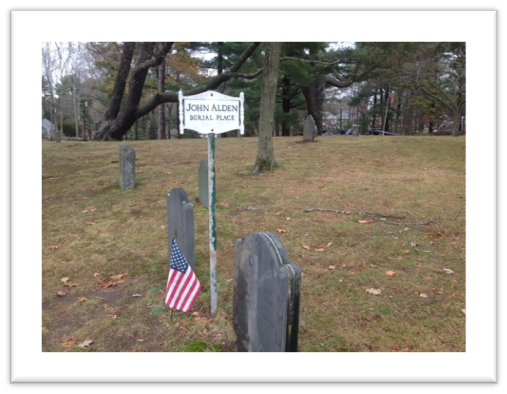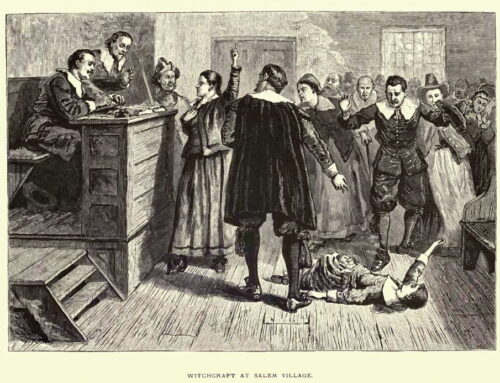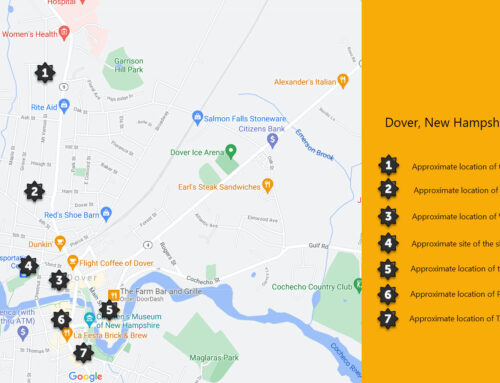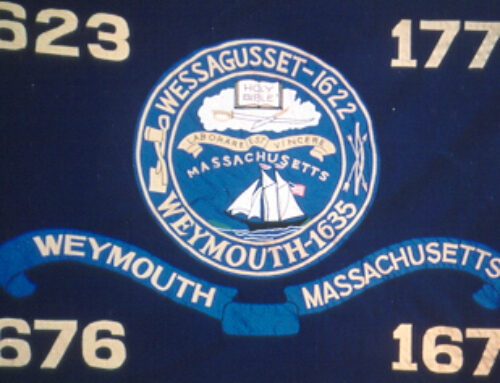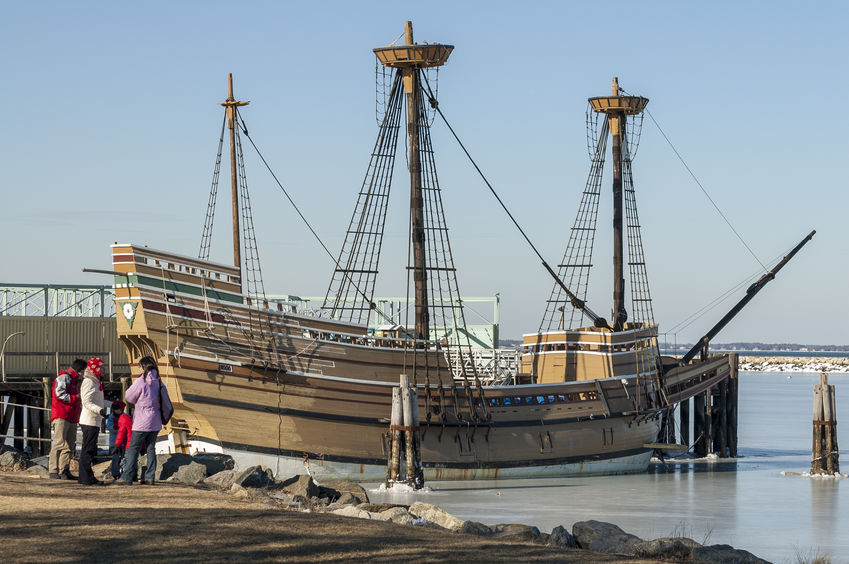
This year (2020), is the 400th anniversary of the Mayflower landing and founding of Plymouth (then spelled Plimoth) Colony. As a member of the General Society of Mayflower Descendants, I had hoped to spend some time on the Cape this summer. Unfortunately, Covid-19 foiled my plans.
But, it still seems fitting to write a series of posts this year devoted to telling the stories of our ancestors who played key roles in Plymouth Colony; not just the Pilgrims who came on the Mayflower, but also those who arrived within the next decade and played a role in this significant milestone in America’s founding story. I did not choose my date of publication randomly. Today, July 22, 1620, exactly 400 years ago, is the day the Mayflower and the Speedwell, loaded for the journey to the New World, met up together in Southampton. As fate would have it, due to repeated issues with the Speedwell requiring repairs, it would be another 6+ weeks before they actually set sail, and on a single ship, the Mayflower.
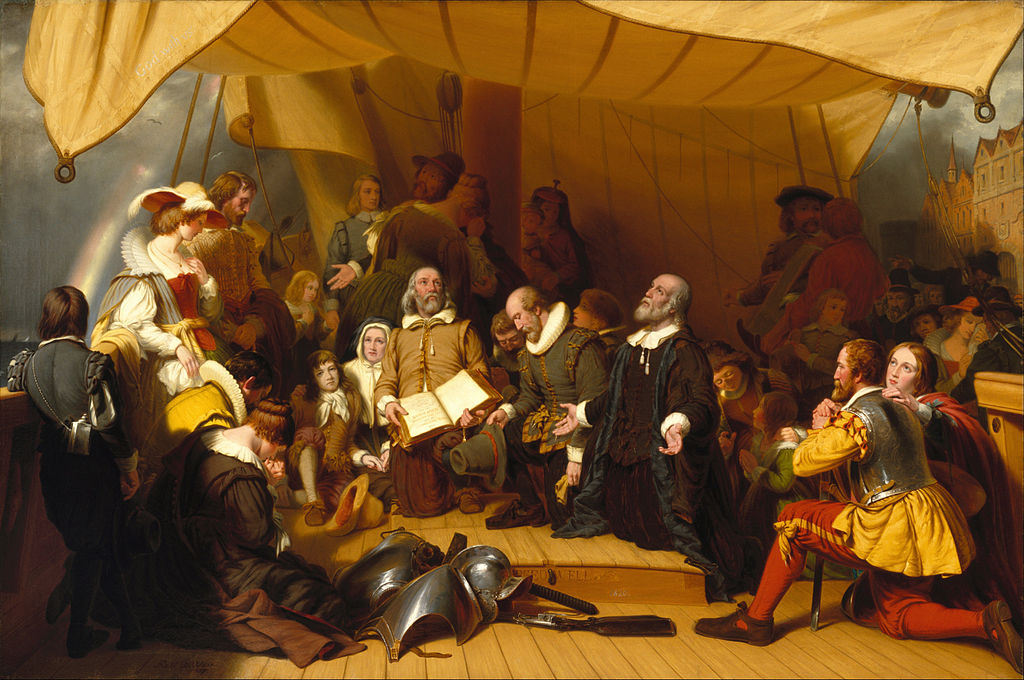
Robert Walter Weir / Public domain | This painting depicts the Pilgrims on the deck of the ship Speedwell on July 22, 1620.
Today’s post will focus on our Mayflower immigrants and future posts will focus on other ancestors who became part of the “cast of characters” within this historical story.
We had a total of four confirmed (and probably seven) ancestors on the Mayflower:
On my mother’s side there was Richard Warren. While Richard came to the New World on the Mayflower, Richard’s wife, Elizabeth Walker and their five daughters made the crossing shortly after him. They arrived in July 1623 on the Anne.
On my father’s side John Alden, Priscilla Mullins (who married John after they arrived in Plymouth), and Priscilla’s parents William Mullins and Alice Atwood.
We are also probably the descendants of two other passengers—James Chilton and his wife (possibly named Susannah Furner). I have yet to find conclusive evidence of paternity for one generation of that branch, but I am including this couple here because while I am still searching for a birth record, the other evidence is quite extensive.
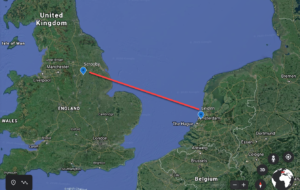 To understand what motivated the Pilgrims to make their trip, we must go back in time more than a decade before the Mayflower crossing, to 1608. It was in this year that a group of Separatist English Protestants (similar but different to the Puritans) from the village of Scrooby, Nottinghamshire moved to Leiden in Holland, with the intention of avoiding the requirement to pledge themselves to the Church of England.
To understand what motivated the Pilgrims to make their trip, we must go back in time more than a decade before the Mayflower crossing, to 1608. It was in this year that a group of Separatist English Protestants (similar but different to the Puritans) from the village of Scrooby, Nottinghamshire moved to Leiden in Holland, with the intention of avoiding the requirement to pledge themselves to the Church of England.
But life in Holland at that time was especially challenging for migrants who were blocked from anything but the lowest paying and most menial jobs. Thus, the migrant families had difficulty supporting their families. In addition to this, the future Pilgrims were concerned about potential corruption of their children living in what they considered the “permissive” Dutch culture. In general, it was not a welcoming environment. In fact, our probable ancestor James Chilton, 63 at the time, and his daughter Mary, age 28, were attacked in April of 1619. During that attack, James was hit in the head with a stone and had an injury serious enough to require the services of a local surgeon by the name of Jacob Hey. The possibility has been forwarded by some researchers that this attack was one of the ultimate deciding factors for the immigration to the New World.
But all in all, the attack on James and Mary aside, this was the motivation for the group of people we now know as the “Pilgrims” wanting to travel to the New World and start a new colony. They sought religious freedom, but they also hoped to find new opportunities for a better life and standard of living.
To fund the trip to the New World, the “Saints” as they called themselves, looked for investors, and found the deal they were looking for with the Virginia Company, which agreed to advance the money they needed for the trip. The Virginia Company had been chartered by King James I who hoped to colonize the New World. The investors would be paid for their investment by the profits from the new settlement, which was intended to be established in northern Virginia.
In August of 1620, the Saints joined with a larger secular group of individuals that they called “Strangers” and all set sail from Southampton, England on two separate ships. Unfortunately, one of the ships (the Speedwell) began to leak almost as soon as they had left port. Ultimately, the two ships returned to the port of Plymouth, England and all the Saints and Strangers crowded onto the Mayflower, captained by Christopher Jones. They sailed out of Plymouth, England much later than intended, on September 6, 1620.
The Mayflower was normally used as a cargo ship, and with a total 132 passengers and crew (numbers vary slightly depending on source, but the most common appears to be 40 Saints, 30 crew, and 62 Strangers) squeezed onto a ship with a living area only about 1600 square feet, the 66 day crossing to the New World was miserable by all accounts.
Think about that. Jim and I have downsized to a smaller home with about 1500 square feet of living space. It feels crowded and chaotic when we have a dozen family over for a holiday get-together. And by today’s standards, our home is quite small. The average home in America in the 21st century is somewhere around 2400-2600 square feet.
So yes, with 132 people aboard, there was crowding, unsanitary conditions, and sickness. With the delays related to the early mishaps with the Speedwell, before they even set sail, their provisions were low. In addition, they withstood several severe storms along the way, damaging the ship, soaking the passengers with seawater, and almost washing them overboard on multiple occasions.
It was finally on November 9, 1620 that they sighted land and quickly realized that they were much further north than their original intention of Virginia. Although they attempted for the next two days to sail south to the Colony of Virginia, the weather prevented their progress and they resigned themselves to remaining where they were. They set anchor on November 11, 1620, at the hook of Cape Cod harbor now known as Provincetown Harbor.

Cape Cod November 2014
Cape Cod can be beautiful in the winter. These are some photos that I took while visiting Cape Cod in 2014, when we spent Thanksgiving at Plimoth Plantation. But New England weather can be funny like that. November was beautiful. The remainder of winter 2014 was one of the stormiest and snowiest I ever remember.

Cape Cod November 2014
Unfortunately, that turned out to be the case for the Pilgrims. November of 1620 was the start of what was to be a harsh winter and the new colonists were unprepared. They did not have suitable shelter and it was too late to build anything, so many wintered in the ship. With their supplies critically low and no time to replenish, they also faced the risk of starvation. Weakened from the crossing, more than half of the colonists died that first winter, including four of our seven ancestors who made the crossing.
As the oldest passenger on board at 64 years, James Chilton, who had worked as a tailor in England, died on December 8, aboard the Mayflower while she was anchored off Provincetown Harbor. James had been born in 1556 in Canterbury, Kent, England to Lionel Chilton and Edith. James’ wife also died that same winter, although the date is unknown. Their daughter Mary was the only one of their children who made the crossing with them. She was orphaned at the age of 13 and it is believed that she lived with either the Alden family or the Standish family after her parents died. Sometime before 1627, Mary married John Winslow and went on to mother many children.
However, we are descended from another of James’ daughters, Isabella Chilton, who made the crossing later (born Jan 15, 1587 and baptized in St Paul’s Parish, Canterbury, Kent, England; died May 5, 1646 in Duxbury, Massachusetts) with her husband Roger Chandler (born April 4, 1580 in Colchester, Essex, England and died sometime between 1658 and 1665, also in Duxbury, Massachusetts).
William Mullins, his wife Alice (probably Atwood), their son Joseph, and a servant, all died that first winter as well. We know that William died on February 21, 1621, at the age of approximately 48, and while the dates are unknown, it is believed the other members of his household died shortly after. The only survivor in the family was Priscilla, from whom we are descended.

Historical recreation of Plimoth Plantation
William was a shoemaker and apparently a rather prosperous one as he was one of the larger investors in the Pilgrim’s voyage. This would have made him one of the more “well off” passengers on the Mayflower. He was born in about 1572 in Dorking, Surry England (about 21 miles south of England), the son of John Mullins and Joane Bridger. Alice’s ancestry is unknown, and there is speculation that Priscilla may actually have been the child of a first wife of William rather than of Alice. If this is true, Priscilla may have been the daughter of Elizabeth Wood, the daughter of John and Joan (Taylor) Wood, who died before 1604. However, most historical accounts count her as one of Alice’s daughters as the first marriage is an uncertainty.
William’s will has the distinction of being the first will written in New England. Governor John Carver wrote it for him while William was literally on his deathbed, and it was witnessed by the Mayflower’s surgeon, Dr. Giles Heale and its captain, Christopher Jones.
However, while these two men were not fated to play a role in the establishment of the new colony, prior to their deaths, they played a role in an event that will always be remembered in history. On November 11, 1620, William Mullins and James Chilton were both among the 41 male colonists who signed the Mayflower Compact; the first governing document of Plymouth Colony and the first document in American history demonstrating the attempt to form a government based of the concept that government should derive its power from the “consent of the governed.” The Mayflower Compact was later used as a model for the Constitution.
As John Alden and Richard Warren were also signers of the Mayflower Compact, 4 (of 41 signers) of our ancestors played a role in this first attempt at democracy in American….an act that still impacts us 400 years later.
Born in about 1578, on April 14, 1610, Richard Warren married Elizabeth Walker (born September 1583) in Great Amwell, Hertfordshire, the daughter of Augustine Walker. Richard made the crossing alone on the Mayflower, choosing instead to make sure he was settled and safe in the New World before his family (his wife and 5 daughters) immigrated on the Anne in July 1623.
 Richard was among the men who first explored the Cape in search of a place for a new settlement, going out on December 6 with Governor John Carver, William Bradford, Myles Standish, Edward Winslow, and 5 others. This exploration did not end well, resulting in what is known as the First Encounter during which they exchanged musket fire for incoming rapid-fire arrows with the local Nauset people. Exhausted from their hard crossing, although nobody was injured, this was a shocking incident to the Pilgrims that was immortalized in a narrative known as Mourt’s Relation written by Bradford and Winslow.
Richard was among the men who first explored the Cape in search of a place for a new settlement, going out on December 6 with Governor John Carver, William Bradford, Myles Standish, Edward Winslow, and 5 others. This exploration did not end well, resulting in what is known as the First Encounter during which they exchanged musket fire for incoming rapid-fire arrows with the local Nauset people. Exhausted from their hard crossing, although nobody was injured, this was a shocking incident to the Pilgrims that was immortalized in a narrative known as Mourt’s Relation written by Bradford and Winslow.
The place where this happened in what is now Eastham, Massachusetts is named First Encounter Beach.
Richard and Elizabeth had two more children after she arrived in the New World, Nathaniel born in 1624 and Joseph born in 1627. But in 1628, at the age of about 50, Richard died of unknown causes.
It is notable that Elizabeth lived for many years after, dying in 1673 at the age of about 90. She never remarried and after inheriting her husband’s property,is distinguished as the first female independent agent in the New World, becoming a shareholder in the colony on March 7, 1636, by unanimous agreement of the court.
Now, to our two most “famous” Mayflower ancestors, John Alden and Priscilla Mullins.
John Alden was born about 1599 in England (his exact origins are still unknown) and migrated to America in 1620 at the age of 21 as a hired hand on the Mayflower. John joined the crew in Southampton where the Mayflower took on provisions. As the ship’s cooper he was given charge of building, repairing, and maintaining watertight barrels and casks, and overseeing the goods stored in them.
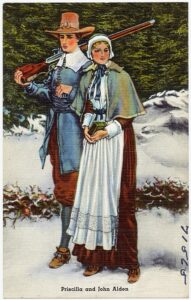
Priscilla and John Alden depicted on a postcard | By Pub. by Smith’s Inc., Plymouth, Mass. Tichnor Bros. Inc., Boston, Mass. – Boston Public Library Tichnor Brothers collection #71565, Public Domain, https://commons.wikimedia.org/w/index.php?curid=46170023
It is possible and perhaps likely, that John was from the Alden family of Harwich in Essex, England. Located northeast of London, Harwich was the homeport of the Mayflower and also the home of Christopher Jones, Mayflower’s captain. This theory is further strengthened by the fact that Jones was related by marriage to the Alden family of Harwich. This would have given the young John Alden many chances to have learned of employment opportunities on the ship. Records also show that there was a John Alden of approximately the same age living in Harwich at that time.
Whatever his origins, John joined the crew and passengers of the Mayflower when it was docked in Southampton and began the famous three month voyage.
There is a legend that John Alden was the first to step foot on Plymouth Rock, a distinction that is shared by fellow Mayflower passenger Mary Chilton, James’ daughter (a many-times over great aunt). Legend claims that John and Mary raced to be the first to step off the boat; the supposed winner of the race varies. Of course, “Plymouth Rock” was never even referred to in the writing of the Pilgrims; it wasn’t until 1740 that the first claim that Plymouth Rock was the landing place of the Pilgrims first appeared. So, if there is any truth to the legend of James and Mary racing, it was almost certainly to a spot other than Plymouth Rock.
The Pilgrims’ joint-stock company had agreed to allow John Alden to decide whether he would stay in their Colony, or return to England. John ultimately decided to stay in the newly formed Plymouth Colony and became an important leader in the founding and government of the colony.
In 1623, John married Priscilla Mullins. Priscilla was born in 1602, to William and (probably) Alice Atwood Mullins in Dorking, Surrey, England. Still a very young woman at 18, when she was orphaned, Priscilla moved in with the Brewster family.
Priscilla is perhaps the most famous of all the Pilgrim women due in large part to the popular legend of a love triangle between John, Priscilla, and Miles Standish dramatized in Henry Wadsworth Longfellow’s poem “The Courtship of Miles Standish” (1858). In that legend, John Alden started out to win the hand of Priscilla for Miles Standish, but instead won the hand of Priscilla himself. Her famous quote being: “Why don’t you speak for yourself, John?”
Longfellow, a descendant of John and Priscilla himself, claimed the story was true, but the historical evidence is inconclusive. Still, the ballad became very popular, and helped immortalize the Mayflower Pilgrims.
When John and Priscilla were married in 1623, it was the third wedding to be held in Plymouth Colony. John and Priscilla were the parents of ten children: six daughters and four sons.
We are descended from their sixth-born daughter Ruth, born February 18, 1632 in Duxbury, Massachusetts.
Distinguished for his practicality, wisdom, integrity, and decision making, John was a leader in the government of Plymouth Colony as well as in nearby Duxbury, where he and Priscilla moved in 1632. John served in a number of important government positions such as Assistant Governor (sometimes serving as acting governor), Duxbury Deputy to the General Court of Plymouth, Captain Myles Standish’s Duxbury militia company, a member of the Council of War, Treasurer of Plymouth Colony, and Commissioner to Yarmouth.
Priscilla Alden has been remembered in history as a strong, opinionated woman. There is an award given every year in her name: the “Speak for Thyself” award that honors exceptional women who make their own choices and serve as pilgrims, pioneers, advocates, and role models.
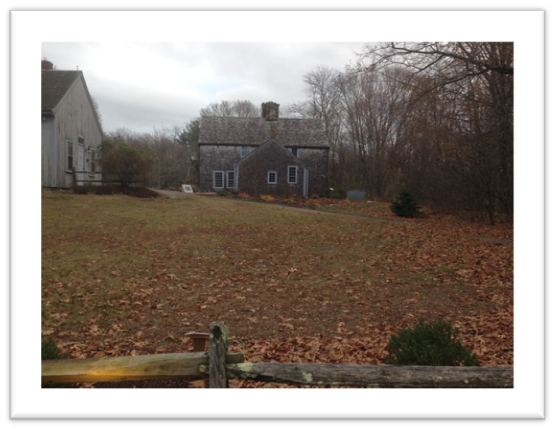
Alden Homestead. Now a museum open to the public. Photo taken in November 2014.
The Alden’s home in Duxbury is now a National Historic Landmark and is a museum open to the public.
John Alden was the last male survivor of the signers of the Mayflower Compact. He died at Duxbury on September 12, 1687. The date of Priscilla’s death is undocumented but it is known that she predeceased her husband.
They are buried in the Myles Standish Burial Ground in Duxbury, notable as the oldest maintained cemetery in the United States. John and Priscilla have the most descendants of all the Mayflower passengers, including President John Adams, President John Quincy Adams, Marilyn Monroe, Orson Welles, Dan Quayle, and Dick Van Dyke.

